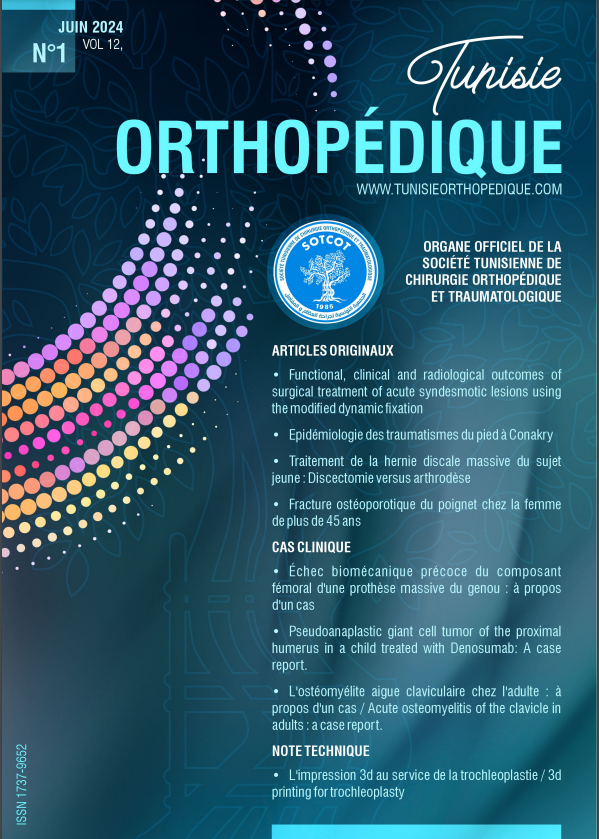Profil type du patient diabétique à haut risque de complications postopératoires après fracture malléolaire
Keywords:
Fracture, Cheville, Diabète, Facteur de risque, Complications postopératoiresAbstract
Background:
The management of malleolar fractures is primarily operative due to their inherent instability. In diabetic patients, there is an increased risk of postoperative complications such as infections, delayed union, wound healing disorders, Charcot arthropathy, and even amputation. However, these complications do not occur in all diabetic patients.
Aim:
To identify predictive risk factors for postoperative complications following open reduction and internal fixation (ORIF) of malleolar fractures in a diabetic patient population.
Methods:
A retrospective case-control study was conducted, including all diabetic patients who consecutively underwent surgery for malleolar fractures between January 1 and December 31, 2020, with a minimum follow-up of two years. Patients were divided into two groups: those who developed at least one postoperative complication (Group 1) and those who had no complications during the follow-up period (Group 2). Risk factor analysis was performed using binary logistic regression.
Results:
The mean age was 57.6 years with a female predominance (sex ratio 1.95). Diabetes was well-controlled in only 18 patients (31% of cases). Bimalleolar fractures were the most common (51%), and an associated dislocation was observed in 27% of cases. Postoperative complications occurred in 29 patients (Group 1), accounting for 49% of our series. Early infection was noted in 10 patients. Two cases of amputation and one death were reported. Multivariate analysis identified three independent risk factors for postoperative complications: poorly controlled diabetes (OR = 7.2; p = 0.004), unemployment (OR = 5.9; p = 0.022), and initial fracture-associated dislocation (OR = 4.8; p = 0.047).
Conclusion:
Postoperative complications are not systematically observed after ORIF of malleolar fractures in diabetic patients. Poor glycemic control is the most significant independent risk factor. Optimal diabetes management and appropriate surgical care can significantly reduce these risks.
Résumé
Introduction : La prise en charge des fractures malléolaires est principalement chirurgicale en raison de leur instabilité. Chez le patient diabétique, il existe un risque accru de complications postopératoires telles que les infections, le retard de consolidation, les troubles de cicatrisation, l'arthropathie de Charcot, et même l'amputation. Cependant, ces complications ne sont pas observées chez tous les patients diabétiques.
Objectif : Identifier les facteurs de risque prédictifs de complications postopératoires après ostéosynthèse des fractures malléolaires au sein d’une population de patients diabétiques.
Matériel et Méthodes : Etude rétrospective comparative de type Cas-Témoins portant sur tous les patients diabétiques opérés consécutivement pour fracture de la pince malléolaire du 1er Janvier au 31 Décembre 2020, et suivis pendant au moins deux ans après l’intervention. Les patients étaient répartis en deux groupes : ceux ayant présenté au moins une complication postopératoire (Groupe 1) et ceux n'ayant présenté aucune complication (Groupe 2) durant la période de suivi postopératoire. L’analyse des facteurs de risques a été effectuée par la méthode de régression logistique binaire.
Résultats : L’âge moyen était 57,6 ans avec une prédominance féminine (genre ratio 1,95). Le diabète était équilibré chez 18 patients uniquement (31% des cas). Les fractures bimalléolaires étaient les plus fréquentes (51%), et une luxation associée était présente dans 27% des cas. Les complications postopératoires étaient observées chez 29 patients (Groupe 1), soit 49% des cas de notre série. L’infection précoce était présente chez 10 patients. Deux cas d’amputation et un décès ont été rapportés. L'analyse multivariée a identifié trois facteurs de risque indépendants des complications postopératoires : le diabète non équilibré (OR= 7,2 ; p= 0,004), l’absence de profession (OR= 5,9 ; p= 0,022), et la présence d’une luxation initiale associée à la fracture (OR= 4,8 ; p= 0,047).
Conclusion : Les complications postopératoires ne sont pas systématiquement observées après ostéosynthèse des fractures malléolaires chez le patient diabétique. En effet, le déséquilibre du diabète constitue le facteur de risque indépendant le plus significatif. Une gestion optimale du diabète et une prise en charge chirurgicale adéquate peuvent ainsi réduire ces risques.
Downloads
Published
Issue
Section
Categories
License
Copyright (c) 2025 Tunisie Orthopédique

This work is licensed under a Creative Commons Attribution-NonCommercial-NoDerivatives 4.0 International License.
Copyright (c) 2025 Tunisie Orthopédique
This work is licensed under a Creative Commons Attribution-NonCommercial-NoDerivatives 4.0 International License.





